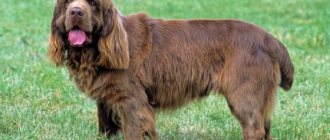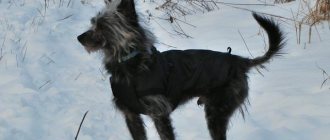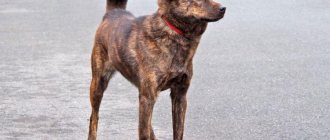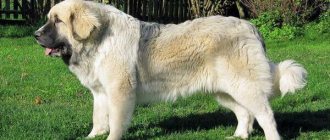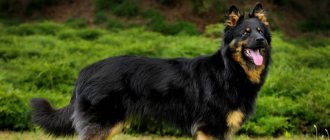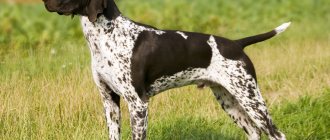a brief description of
- Other names: Tibetan Spaniel, Simkhyi, Tibbie, tibbie.
- Height: 25-26 cm.
- Weight: from 4.0 to 7.0 kg.
- Color: Any coat color is acceptable, white spots on the paws are acceptable.
- Coat: double coat with thick undercoat, thick, silky, long along the neck and tail.
- Life expectancy: up to 16-18 years.
- Advantages of the breed: Tibbies have a loyal character with a sufficient level of intelligence. A characteristic feature of the breed is considered to be an active life position and courageous actions.
- Difficulties of the breed: Dogs are stubborn and overly self-confident. A high level of energy forces the owner to spend more time walking or playing active games.
- Price: up to 1000 euros.
Appearance
The Tibetan Spaniel is a small, energetic dog of an elongated format with a relatively miniature head, without signs of coarseness. The height at the withers is approximately 25 cm, and the weight is 4-7 kg. The appearance of Tibetan spaniels is very different from other small Tibetan dogs, terriers and Lhasa apsos, but at the same time they have an undeniable resemblance to the Pekingese and Shih Tzu, which, apparently, are distant relatives.
The muzzle is of medium length, without wrinkles, with a small chin. The eyes are expressive, clear, set wide. The ears are set high, drooping, and small. Adult dogs are decorated with fur. A small undershot is considered typical for the Tibetan Spaniel, but the tongue and teeth should not be visible.
In general, the Tibetan spaniel should look harmonious. The neck is strong and short. Ribs with good curve. The legs are relatively short. The bones are strong. The paws are small and neat. The back is of moderate length, straight. The croup is sloping. The tail is set high, curled in a ring over the back, and very well feathered.
The wool is thin, soft, silky. Short on the muzzle and front of the legs, moderately long on the body, fitting well to the body. The undercoat is thin and dense. The ears, neck, tail and back of the legs are decorated with feathering, which is especially noticeable in males. Any colors are allowed, the most common being golden. In the homeland of the breed, the dark color with a white spot on the chest is valued, which, according to Tibetan beliefs, symbolizes a pure heart. The spot on the forehead is the sign of a Buddha, and the white tail indicates the dog's thieving tendencies.
History of the origin of the breed
A small decorative dog, resembling a large Pekingese in appearance, belongs to the Tibetan spaniel breed. It is possible that the Pekingese played a certain role in the development of the breed, or is considered the closest relative of the Tibby, but there is so little information about the origin of the Tibetan Spaniel that either hypothesis may apply.
The first mention of small dogs serving in a Tibetan monastery was mentioned around the 8th century AD. Dogs were given a sacred role when the monks performed their rituals - tibbies turned prayer wheels.
Over time, the Sacred Supreme Law underwent changes, and dogs were removed from their positions. But they remained in the monasteries, where they were very careful about breeding the breed, not allowing inbreeding with other breeds.
Trade relations between Tibet and China were built on the exchange of goods, which included dogs. It was during this period that dog breeders in China received the Pekingese, which itself could participate in the production of the Tibetan spaniel along with the Shih Tzu and pugs.
The European cynological community became acquainted with the Tibby only at the end of the 19th century. Tibetan spaniels were introduced to dog lovers in the British kingdom only in 1898 as debutants at the annual canine exhibition. And some representatives of the breed came to England only in 1905.
For a long time, Poda remained little known, and even at the present stage, Tibbies are in little demand - they are not well known, since the owners do not seek to popularize the breed. The breed was first described in Europe in 1934, after which the standard was revised several times.
At the present stage, the Tibetan Spaniel breed standard, approved by the International Canine Federation in 1997, is in force.
History of the breed
Tibetan spaniels are very ancient, they appeared long before people began to record dogs in stud books. When Europeans learned about them, Tibetan spaniels served as companions to monks in the monasteries of Tibet.
However, they also had practical applications. Like the lion statues at the entrance to the monastery, they were located on the walls and looked out for strangers. Then they started barking, which was attended by serious guards - Tibetan mastiffs.
These dogs were sacred and were never sold, but only given as gifts. From Tibet they came to China and other countries with Buddhist traditions, which led to the emergence of such breeds as the Japanese Chin and Pekingese.
But for the Western world they remained unknown for a long time and only in 1890 they came to Europe. However, they did not become famous until 1920, when an English breeder became seriously interested in them.
He actively promoted the breed, but his efforts went to waste with the outbreak of World War II. Most breeders could not maintain kennels, and the rest had no time for exotic dogs.
It was only in 1957 that the Tibetan Spaniel Association (TSA) was created, through whose efforts the breed was recognized by the English Kennel Club in 1959. This accelerated the development of the breed, but until 1965 they remained unpopular.
It was only in 1965 that the number of registered dogs increased to 165. Despite the efforts of breeders, the number of dogs is growing very slowly to this day.
So, in 2015 in the USA they ranked 104th in popularity, out of 167 breeds, and in 2013 they rose to 102.
Purpose
, small dogs - Tibetan spaniels - performed regular guard duty The dogs were placed on a hill so that they could see the surrounding area around the monastery. The dogs reported any intruded foreign elements immediately. Their sonorous barking could be heard loudly from the heights.
Tibbies served a warning function, and the territory was guarded by taciturn Tibetan mastiffs, scaring away uninvited guests with their ferocious appearance and monstrous size. This is how the peace of the holy lamas was protected.
In addition, tibbies were used as living hot water bottles, warming the beds of saints with hot bodies. Tibetan spaniels were also assigned to the sacred drums. The dogs were required to spin movable structures during the ritual of sacred rites and reading prayers.
Character
Almost everyone who has interacted with Tibetan spaniels notes high intelligence and special friendliness towards those with whom the tibby was previously acquainted. The little dog treats strangers with cold distrust.
In a dog’s gaze, if you are unfamiliar, you can read a range of negative emotions from contempt to disgust. Tibby adores family members and endures forced separation extremely painfully.
These small decorative dogs are endowed with simply monstrous energy, since such a state cannot be called simply mobility. This is a pulsating clot of energy that needs regular release. Therefore, even a puppy needs to be walked a lot and effectively with games and elements of the initial training course, although these dogs are not obedient enough, but they are quite independent and willful.
The character of the Tibetan Spaniel manifests itself with the birth of the puppy. But they are not aggressive and do not bite, but they can talk about a soul overflowing with feelings for hours. Yes, so that the whole neighborhood is aware of the matter.
Tibbies are apathetic when it comes to training, and this is the biggest problem of the breed. To make a Tibetan spaniel into a companion dog, you need to put in a lot of effort, energy, time and perseverance. They begin to raise a dog from the “crawlers” age, exposing it to the process of socialization as early as possible.
Choosing a puppy
You can plan to move your puppy to a new apartment only after reaching 8 or 12 weeks of age. By the age of two and three months, puppies have completed their quarantine periods for their first mandatory vaccinations.
When choosing a puppy, they are guided not by the appearance of the baby, but by his parents - how well they correspond to the breed standard. The buyer's interest in the parents' health certificates is quite justified, and the breeder must provide them without fail . Otherwise, the stories that these are very strong dogs and practically do not get sick can be considered unfounded.
The puppy's health is indicated by its activity. He is extremely playful, active and inquisitive. He has a fairly long body, a dome-shaped head, a flattened muzzle and a flat back.
A swollen belly indicates possible damage to the puppy’s gastrointestinal tract by helminths. Don’t be afraid to ask the breeder if the deworming procedure was carried out and how long ago it was carried out.
Expressive and wide-set eyes should be clear, as should the ears. Overshot - a slight protrusion of the lower jaw above the front - is considered a characteristic feature of the breed. The color can be varied, but the coat is clean, without harmful odors and ammonia odors.
For Tibetan Spaniel puppies, the price is determined not by age or parental merits, but by gender. As a rule, females are much more expensive than males. This is due to the complaisance, calmness and moderate obstinacy of girls, unlike boys. Since the breed is considered extremely rare, the cost of a puppy varies around 1000 euros.
Nicknames for dogs
The dog moves to a new home with the name given by the breeder. The entire litter is assigned one letter of the alphabet in accordance with the nursery stud book. The new owner can keep the name given to the dog, but can also rename the puppy.
There are no barriers to assigning a pet name to a puppy, except that in the show annals the dog will appear under an official name with the factory prefix of the kennel.
At one of the exhibitions, a pretty, intelligent girl with the sonorous name Manya attracted attention. During the award ceremony, her official name was heard - Mirabelle Fon, and a long, but very beautiful English-language prefix from some diamond mines of almost King Solomon.
And in everyday life it’s the charming Manya, or Zach, Chris, Filya and numerous pet names for wonderful pets. The main thing is names that are sonorous, easy to pronounce and loved by dogs.
Care and maintenance
Tibbies are indoor dogs . They are not intended for aviary keeping. Even for such a restless breed as the Tibetan spaniel, there must be a place in the house where the dog will feel alone and can sleep.
If a dog is purchased on the eve of the winter season, then the puppy can be taught to use a litter box, and as the weather warms up, devote time to walking outside. But it is better to immediately accustom your pet to warm clothes - overalls and slippers, which he is destined to use every time winter comes.
Walking is very important for active spaniels. Walks should be long and involve maximum physical activity. At first, be sure to praise after each bowel and bladder release. .
Dogs should not be prohibited from actively playing with their own kind, even if it seems that the game has dragged on significantly. The Tibby's irrepressible energy must be completely exhausted. When walking in crowded places during the socialization stage, the dog must walk on a leash.
Caring for your pet is simple and involves careful, regular brushing of the fur. One procedure per week is enough to keep your dog looking great. This does not apply to show dogs, which are brushed much more often. Frequent bathing is contraindicated for dogs. But if such a need arises, the wool is immediately dried with a hairdryer or a special compressor.
Ears require constant care. Ears are cleaned twice a week, and the auricle is checked daily. The eyes are also examined every day, but are periodically washed with special ophthalmic solutions. The claws are trimmed as they grow.
Who is the dog suitable for?
Tibetan Spaniels are good with children as long as they are unobtrusive. Therefore, this breed can be started in families with older children (from 7 years old). This dog also gets along well with people who do not lead a very active lifestyle. The older the Tibby, the less physical activity he requires. Hiking is more suitable for him.
Since the Tibetan Spaniel is very sociable, it cannot withstand prolonged solitude. Therefore, it is better not to start one for people who are constantly busy at work. Aggressive, grumpy families are also not suitable for this dog.
Health and heredity
We can safely say about Tibetan spaniels that the dogs have excellent health and strong immunity. But there is a breed predisposition to diseases associated with freedom of breathing and cardiac activity of the body.
Diseases of the musculoskeletal system are inherited. It is extremely rare that the fact of spinal lesions with the formation of intervertebral hernias, which bring severe pain to the dog, is stated. Veterinarians also note a breed tendency to allergic dermatitis due to flea bites.
Diseases and life expectancy
In adulthood, representatives of the breed may experience problems with their teeth, or rather, the formation of tartar. Therefore, the dog must be taught oral hygiene from an early age. During the period of changing teeth, you need to carefully monitor the oral cavity. If the molar tooth is already coming in, but the baby tooth still won’t fall out, then you need to contact a veterinarian.
According to breed standards, this type of dog has floppy ears. Associated with this is the possibility of getting otitis media.
Dogs are especially susceptible to this disease after situations such as:
- Hypothermia;
- Walking in very hot weather;
- Swimming in any bodies of water;
- Staying in the rain for a long time.
Therefore, once every three days, the spaniel’s ears need to be inspected and cleaned as necessary.
If the dog fully complies with the standard, then he should not have any problems with his eyes. But when a dog's face is flattened, increased tearing may occur. Copious discharge and swelling of the mucous membranes are signs of conjunctivitis. It occurs when a dog has allergies and colds. In this situation, it is necessary to consult a specialist and begin treatment.
Additional Information:
- Most breed diseases are inherited.
- The life expectancy of the Tibetan Spaniel is up to 15 years.
Nutrition
The diet of a Tibetan spaniel is practically no different from feeding small breed dogs. Restrictions exist only in the consumption of fats that cause problems with the pancreas.
If owners prefer to feed their dog dry food, then select a diet containing lamb, rabbit or duck meat, but in no case chicken, since chicken meat can provoke food allergies.
With natural feeding, 2/3 of the diet is allocated to products of animal origin. Naturally fed Tibetan Spaniel puppies should receive the full amount of nutrients, as well as the elements necessary for growth and development. Therefore, in addition to meat, the menu should contain:
- sea fish;
- cottage cheese;
- dairy products;
- eggs;
- butter as a supplier of vitamin A.
Your dog should have fruits and vegetables in his daily diet. Water - around the clock. The feeding schedule for puppies and adult dogs is standard, but adult representatives of the breed are fed at least twice a day.
Description of the Tibetan Spaniel breed
The dog's height is relatively small, its maximum height at the withers is 26 cm. The average weight of the dog is 4-7 kg. In the photo of a Tibetan spaniel, you can see what a standard representative of the breed looks like.
Basic breed standards:
- The head should be convex and wide. The eyebrows are brightly defined with a wide arch. The muzzle is slightly flattened, without folds.
- The eyes are brown, oval in shape, outlined in black.
- The nose is black.
- Bite with a small snack. But the lower lip covers the upper fangs. Lips pressed close to teeth.
- The body is elongated in shape. The transition from the head to the body is not clearly expressed, since the neck is short.
- The ears of the Tibetan Spaniel are drooping and long with feathering in some places and are not cropped according to the standard.
- The front legs are small and slightly curved inward. The hind legs are more muscular. All limbs are short and do not overlap each other when walking.
- The dog's loin is short. The back has a strong croup and a straight line. It should not sag in any way when moving, and the croup should not rise above the back.
- The dog's tail is ring-shaped and fluffy, located high, tightly pressed to the back. Covered with long hair, not docked.
Tibetan Spaniel puppies that fit this standard description are most easily found in specialized kennels.
Coat type and color
The Tibetan Spaniel has a soft and silky coat of medium length. There is usually a thick undercoat, which is thicker in males.
Attention! To avoid skin diseases and the formation of tangles, the animal’s coat should be closely monitored. It needs to be combed thoroughly and the pet needs to be given a haircut from time to time.
The color palette of small dogs is very diverse: from light shades with tints to dark tones. But the most preferred color is dark, with white markings on the chest, forehead or tail. The rarest is the golden coat without dark markings.
Training
Tibbies have average learning abilities. This indicator means that for the dog to assimilate a command, the owner must repeat it up to 40 times, and the Tibetan spaniel follows the owner’s orders every fifth time.
Many people note the wonderful properties of the Tibby as a companion dog, but are silent about how much effort and resources are required on the part of both the owner and the dog to achieve these qualities.
On long walks with a Tibby, it is better to use all kinds of toys so that the dog can fully throw out the accumulated energy. Don’t be surprised, but the dog will take all the toys, sticks and balls back into the house, without losing sight of anything, and will guard them, placing them around his place.
Advantages and disadvantages
It is not typical for the Tibetan Spaniel to spend time at the owner's side, watching television programs throughout the day. They cannot sleep for long periods of time and must constantly move. Bred to serve in any weather, the dogs easily adapt to seasonal changes.
Modern representatives of the breed are very afraid of drafts and severe frosts, unlike their ancestors, but they tolerate hot summer days well, unlike their short-faced counterparts. Despite the fact that dense wool protects well from precipitation, it is advisable to dress dogs in bad weather.
Tibbies are also very affectionate and treat children with extreme care. Dogs do not pay much attention to other inhabitants of the house, and they do not experience aggression towards cats.
Recently, specially trained Tibetan spaniels have been used in canistherapy programs for their amazing ability to relieve stress and nervous tension in humans.
The disadvantages of the breed include a stubborn and willful character, as well as the ability to independently make any decision.
Character and intelligence
Tibbies have nothing in common with ordinary spaniels. The security functions of this dog are already a thing of the past. Today it is a friend and companion, endowed with high intelligence and devotion, strongly attached to the owner. Tibbies are friendly towards children, especially older ones, if they feel respect from them. They get very bored without communication. If left alone for a long time they can become destructive. The breed is very sensitive and does not tolerate an environment where there are scandals and quarrels.
Tibby's character is stubborn and independent. This makes them very similar to cats. They are very self-confident, with a sense of self-esteem. When approached on the street, he will respond when he deems it necessary.
They rarely show jealousy. In general, Tibetan spaniels are not confrontational and are tolerant of other animals in the house. They treat strangers with suspicion. But if there is no threat from them, they make contact.
Reviews
Natalia:
His name is Pirate. Came to us three years ago as an inheritance from my grandfather. The dog is almost 16, but I have never met a more intelligent, understanding and loving creature. I didn’t even suspect that so much dignity could fit in a small body. But the only sin belongs to the Pirate. He is madly in love with sweets, and can even steal them, but more often he pitifully and persistently begs for them.
Eugene:
When buying a puppy, oddly enough, on a bird, I was sure that I was getting a Pekingese. And he remained in this confidence for a whole year, until he grew luxurious hair and began to weigh more than 6 kilos. We took him to the club next door, where they determined the breed for us. I am grateful to fate, which so suddenly confronted us with a Tibetan spaniel - our joy and companion in all events. PS Extremely healthy breed.
Larisa:
He doesn't bark or bite. I hear the voice of a dog on rare occasions, and only if something supernatural has happened. I came across a very sensitive boy. If I'm not in a good mood, he won't come close. And if she’s in a good mood, she’s always there, looking into your eyes, wagging her tail, and doesn’t mind playing.
Our sections are devoted to breeds known and not so well known, such as this one - the Tibetan spaniel. We will be incredibly glad to hear your feedback about this extremely little-known breed in our region - the wonderful decorative Tibby dogs, or Tibetan spaniels. You can leave reviews and comments at the bottom of the article. Additions to the text and information not included in the article are welcome.
Share
Leave a review

